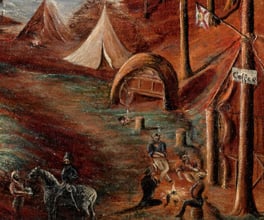Transport
After sometimes three or four months at sea, the trip to the goldfields was the next hardship to be faced by the miners. Many were unprepared for the physical exertion of walking for days at a time. Depending on the season, they faced the dangers of bogged animals and fast-flowing streams or duststorms and water shortages.
The paths they took were often the same ones that Indigenous Victorians had taken for millennia and it was only with Indigenous help that some were able to make it to their destinations. Historian Dr Fred Cahir notes that the knowledge and skill of Indigenous Victorians was essential to new miners. He cites the popular 1853 guide book The Gold Finder of Australia:
[A]fter great difficulty we were happily enabled to complete a bargain with two of the natives [Djadjawurrung guides] to put us upon a track that would lead us to Forest Creek [...] For this piece of service we would almost have given all the gold we had.
- John Sherer
John Sherer in Cahir, F 2010, 'Are you off to the diggings?' The La Trobe Journal State Library of Victoria Foundation, July, Vol. 85.
Even on established routes, the primitive roads of the colony were constantly criticised. The failure to provide decent roads to the diggings was one of the most common complaints levelled at Lieutenant Governor La Trobe. Some improvement to horseback and the bullock dray came with the arrival of the Cobb & Co transport company in 1854. They were the first to bring reliable coaches that ran to schedule.
Cobb & Co maintained successful routes between Melbourne, Castlemaine, Bendigo and Ballarat. A trip of 100 kilometres could now be made in one long day and for as little as £4.The first Cobb & Co coaches were built in America for American conditions. Their suspension and construction quality made them far superior to those built on the old English designs. Soon coaches like the 'Leviathan' were carrying nearly 100 passengers:
[The coaches cast] by night a powerful glow from their five double-reflector lamps, two at the front on either side, and one in the middle...the number of horses varied with the particular vehicle and route, but teams ranged from two to eight. The average speed of the vehicles was up 10 m.p.h. [16k.p.h] Regularity, punctuality and courtesy were the main features that the firm built its reputation upon. The first Cobb drivers were brought out from America. Tough men, moustachioed dare-devils in wideawake hats and buckskin breeches, smoking huge cigars, they seemed to be afraid of nothing. Floods, bushfires, the assaults of bushrangers - they took them all in their stride [...] A good driver could earn up to £1000 a year.
- Bill Wannan
Wannan, B 1978 Bill Wannan selects stagecoach stories of old Australia: a box-seat miscellany, Macmillan, South Melbourne, Vic.
Stagecoaches were succeeded by trains. Edward Snell’s Melbourne–Geelong railway had linked the two cities in 1857 in an attempt to lure shipping to Geelong. Many thought it would have been far better to connect the goldfields to Melbourne and Geelong. It was not until 1862 that Geelong was connected to Ballarat. The cost of laying track on swampy terrain delayed the construction of a direct line from Melbourne to Ballarat until 1889.











